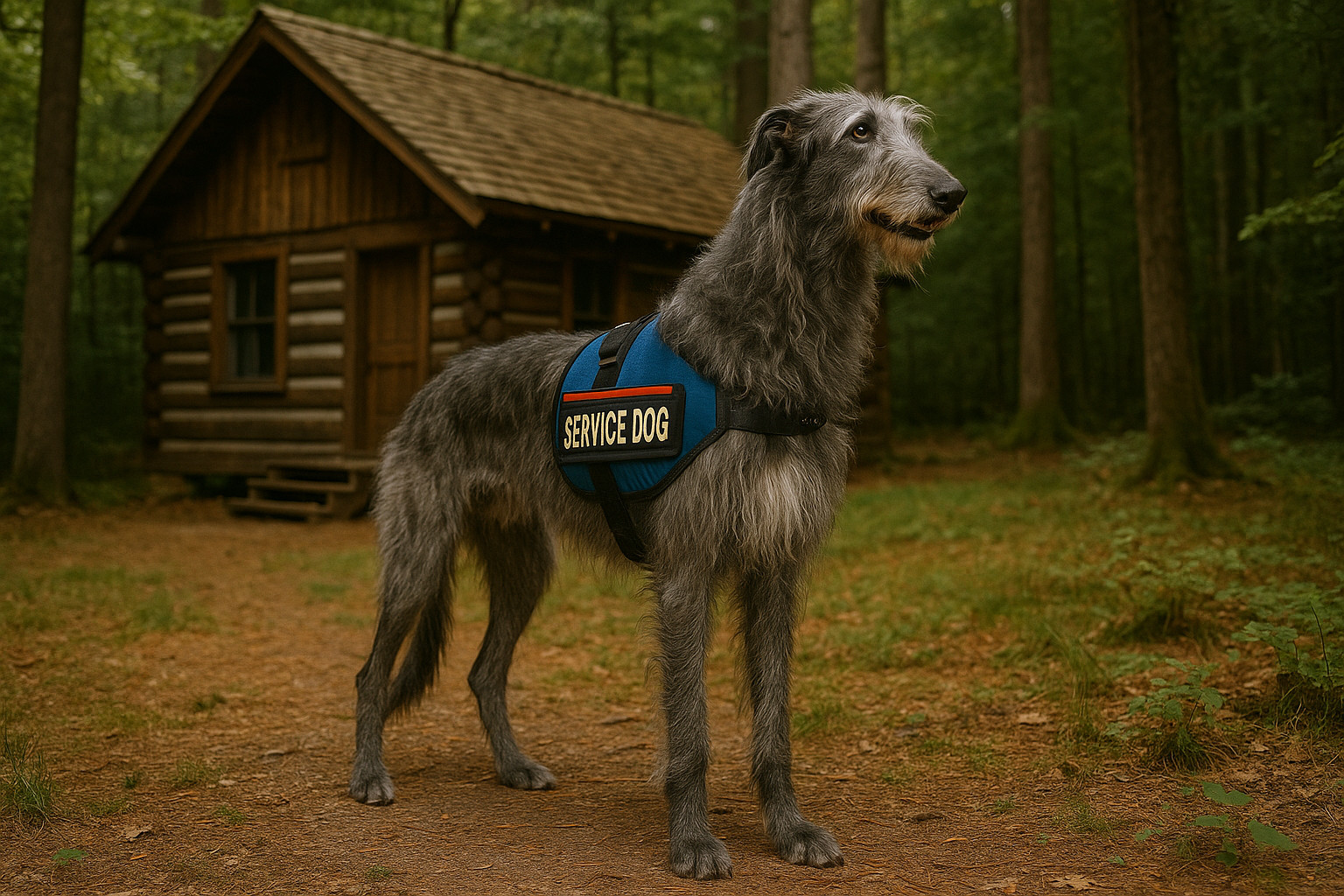Scottish Deerhound as a Service Dog

The question of whether a Scottish Deerhound can serve effectively as a service dog prompts an exploration into their history, temperament, physical attributes, and training potential. Known for their grace and dignified appearance, Scottish Deerhounds might not be the first breed that comes to mind when considering service dogs; however, their unique characteristics can lend themselves to specific service roles.
Scottish Deerhound Overview
Scottish Deerhounds, hailing from Scotland as their name suggests, are ancient sighthounds bred originally to hunt red deer over the hilly terrain of their homeland. Known for their gentle demeanor, these dogs are notable for their elegant and noble stature. Despite their hunting past, in contemporary times, they are recognized primarily as loyal and calm companions.
Physical Characteristics
Scottish Deerhounds are large dogs, typically standing 28 to 32 inches tall at the shoulder and weighing between 75 to 110 pounds or more. They possess a wiry, somewhat rough coat that comes in various shades of gray and brindle. Their large size and strength, combined with a built-for-speed slender physique, give them an athletic appearance that can be both an advantage and a disadvantage for service work.
- Size: Their considerable size can be beneficial in tasks that require physical support or mobility assistance. However, their size may pose challenges in environments requiring agility in tight spaces, such as crowded urban environments or small indoor settings.
- Energy and Exercise Requirements: While they require daily exercise, Scottish Deerhounds are surprisingly low-energy indoors, preferring to lounge peacefully when not in action. This moderate energy level is beneficial in keeping them calm and collected, a desirable trait for service work that demands focus over long periods.
- Physical Strength: Their physical strength allows them to perform tasks such as carrying items or providing balance support. However, their size and strength necessitate a handler capable of managing such a large dog effectively.
Temperament and Attitude
Scottish Deerhounds are often described as gentle giants. They tend to possess a serene and friendly disposition, displaying affection and loyalty to their family. Known for their patience, they generally have a calm demeanor which can be beneficial in public and stressful environments.
- Calmness: This breed is generally calm and not easily provoked, qualities that are advantageous in a service dog as they are less likely to react negatively in potentially stressful environments.
- Sociability: Scottish Deerhounds typically exhibit friendliness towards strangers and other animals, which is critical for service dogs that must operate smoothly in public spaces.
- Independence: These dogs can be somewhat independent thinkers due to their hound nature. While they are usually willing to please, this trait might require a nuanced training approach to ensure consistent obedience and engagement.
Types of Service Work
While not commonly seen in service dog roles, Scottish Deerhounds can be suited for certain types of service work due to their temperament and physical attributes.
- Mobility Assistance: Their large size and strength are ideal for providing balance support and helping with mobility tasks. Scottish Deerhounds can assist individuals with balance issues by providing a sturdy presence to lean on.
- Emotional Support and Therapy Dogs: Due to their calm and gentle nature, Scottish Deerhounds make excellent therapy dogs. Their comforting presence can be invaluable for individuals dealing with emotional or psychological challenges.
- Medical Alert Dogs: With proper training, Deerhounds can be taught to alert to specific medical conditions. However, their effectiveness in this role would depend heavily on early and thorough training.
Health Considerations
Health is a significant factor when considering any dog for service work. Scottish Deerhounds are generally healthy but have predispositions to certain conditions.
- Bloat (Gastric Torsion): Like many large breeds with deep chests, Scottish Deerhounds are susceptible to bloat, a life-threatening condition that requires immediate veterinary care. Regular feeding schedules and a calm post-meal environment are crucial preventive steps.
- Osteosarcoma: Bone cancer is relatively common in this breed. Regular veterinary check-ups to catch early signs are essential for long-term service capability.
- Heart Issues: Cardiomyopathy and other heart conditions can occur in Scottish Deerhounds, which may impact their stamina and suitability for roles requiring physical exertion.
Training and Suitability
Training a Scottish Deerhound as a service dog requires an understanding of their sighthound nature. Historical breeding for speed and independence in hunting can influence their responsiveness to training.
- Trainability: While they are intelligent dogs, Scottish Deerhounds can exhibit an independent streak. Positive reinforcement methods and patience can yield excellent results, but handlers may need to be creative and persistent.
- Focus on Socialization: Early and continuous socialization is essential to acclimate them to various environments, people, and other animals.
- Consistency and Patience: Due to their potential for independence, consistent training sessions that reinforce desired behaviors are crucial.
Summary of Scottish Deerhound
Scottish Deerhounds offer an intriguing mix of attributes that can lend themselves well to specific service roles, particularly those requiring calmness and strength. However, potential handlers should consider their size, health predispositions, and independent demeanor. This breed may not fit all service dog roles but can be invaluable in certain situations.
Strengths:
- Gentle, calm temperament makes them suited for emotional support roles.
- Large size and strength are beneficial for mobility assistance tasks.
- Generally sociable and friendly demeanor in public settings.
Weaknesses:
- Size can be cumbersome in tight or crowded spaces.
- Health concerns, such as bloat and osteosarcoma, may impact longevity and physical capability.
- Independence may challenge training consistency and responsiveness.
Ideal Roles:
- Mobility Assistance
- Emotional Support
- Therapy Work











